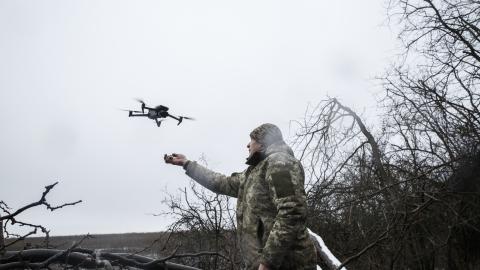Below Hudson Senior Fellow Can Kasapoğlu offers a military situation report about the war in Ukraine.
1. Battlefield Update: Tactical Changes at the Expense of Mounting Losses and Destruction
Once again, the previous week witnessed no strategic changes in battlefield geometry. Nonetheless, tactical advances from the Russian military have been continuing with concerning success. These advances have come at the expense of significant losses of equipment and personnel, which the Russian high command is willing to tolerate.
As previous editions of this report anticipated, Ukrainian combat formations have largely halted counteroffensive operations. As winter settles in, they have shifted to a defensive posture across almost all fronts. On most of these fronts, Ukrainian forces have managed to hold the line and deny strategic Russian pushes. In certain sectors, however, the Russians have advanced into deeper territory, especially in Siversk, a town in Donetsk Oblast.
At present, Russia’s main offensive efforts remain focused on the axes of assault running southeast to east. The primary assault is serving two objectives: capturing the remainder of Luhansk and Donetsk Oblasts while maintaining the pressing operational tempo on the southern front. In the southeast, clashes in Avdiivka, Marinka, and Bakhmut continue. In Avdiivka, Russian forces are attempting envelopment maneuvers, with partial success. The overall situation is becoming more perilous for Ukraine’s fighters, who must work to ensure their defensive positions are not encircled.
In the fierce battles of southeastern and eastern Ukraine, Russian forces have suffered as many deaths in two months as in the initial phase of the conflict altogether. In Avdiivka, Russia has made its most significant territorial gains since the fight for Bakhmut, but these gains have amounted to no more than four square miles, at a cost of over 3,000 lives per square mile. Russia’s ongoing push for the city highlights the high costs it must endure for minimal gains in the quest for territory. Vladimir Putin’s recent dismissive comments on the war showcase his indifference to the loss of Russian and Ukrainian lives.
In the south, fighting along the Zaporizhzhia axis remains heated. The Ukrainian bulge in Robotyne and Verbove remains intact, with no significant Russian advances or pushbacks. Ukraine’s Armed Forces have also retained tactical bridgeheads on the Dnipro River's left bank, stymieing Russian attempts to eliminate those small but valuable spearheads.
In the meantime, Ukraine’s defense technological and industrial base (DTIB) has introduced a new asset to the battle space. To counter Russia’s air and missile attacks, the Ukrainians now have a kamikaze drone, the AQ-400 Scythe. The loitering munitions baseline possesses an operational range of approximately 750 kilometers (466 miles), and carries a 32-kilogram (70.5-pound) warhead; it can also carry a heavier 70-kilogram (154.3-pound) warhead to distances within a shorter range. Although Russia’s Iran-produced Shahed-136 can transport a 40-kilogram (88.2-pound) warhead up to 2,000 kilometers (1,243 miles), Ukraine’s new drone provides it with a valuable weapon. More important, the AQ-400 Scythe has a relatively low price tag of $15,000, which enables its production in large quantities.
As drones of all types and sizes proliferate over Ukrainian skies, Russian forces continue to adapt. Open-source intelligence suggests that Russia is now equipping an increasing number of ground combat platforms with electronic warfare (EW) assets in an attempt to shield its vehicles from attacks by Ukrainian unmanned aerial vehicles (UAVs). This highlights the increasingly digitalized nature of the conflict—and the importance of EW dominance in modern war.
2. Russian Aerial Attacks Continue and Intensify
Over the past week, Russia maintained its high-tempo aerial assault posture in strikes against Kyiv. According to the Ukrainian Air Force, the Russians attacked the capital with a mixed strike package consisting of Shahed kamikaze drones and a wide variety of missiles. The night of December 14 featured a particularly intense combination of air and missile salvos throughout the country: Ukrainian officials reported that the Russian aerial offensive included Shahed loitering munitions, Kinzhal aeroballistic missiles, Kh-59 air-launched cruise missiles, and S-300 missiles modified for land-attack roles. These strikes covered a wide set of targets throughout Ukraine, including in Kyiv, Odesa, Mykolaiv, and Kharkiv.
President Volodymyr Zelenskyy announced that all ballistic missiles launched at Kyiv had been successfully neutralized by Ukrainian air defenses. However, the fragments of the intercepted missiles—and possibly some Shahed drones that broke through the defenses—caused significant damage in civilian settlements, reportedly injuring 51 people, including some children. The attack also severely impacted critical national infrastructure such as telecommunications lines, disrupting internet and cellular services.
3. Ukraine’s Boosted Tank Brigade Is Nearly Combat-Ready
Recently released video uploads showed Ukrainian tank crews training on Leopard 1A5 tanks in Germany last autumn. Initial assessments suggest that these troops possibly belong to Ukraine’s 5th Tank Brigade.
The footage offers some significant additional information. Most importantly, it reveals the introduction of Leopard 1A5s to Ukraine’s arsenal. In addition to US-transferred M-1 tanks, the Leopard gives a significant boost to Ukraine’s armored warfare capabilities. Fully arming the 5th Tank Brigade with Leopard 1A5s would involve using over half of the nearly 200 tanks pledged by a German-led consortium.
While the tanks no doubt improve Ukraine’s fighting forces, the Leopard 1A5 remains vulnerable. While it is a well-built, 40-ton, four-person tank known for its mobility and precision, the platform has been criticized for its relatively thin 70mm armor, the weakest among major tanks used in the current conflict. Still, the 5th Tank Brigade is now nearing full strength. In a reloaded counteroffensive, especially when backed by local air superiority, the unit could be capable of delivering promising results.














